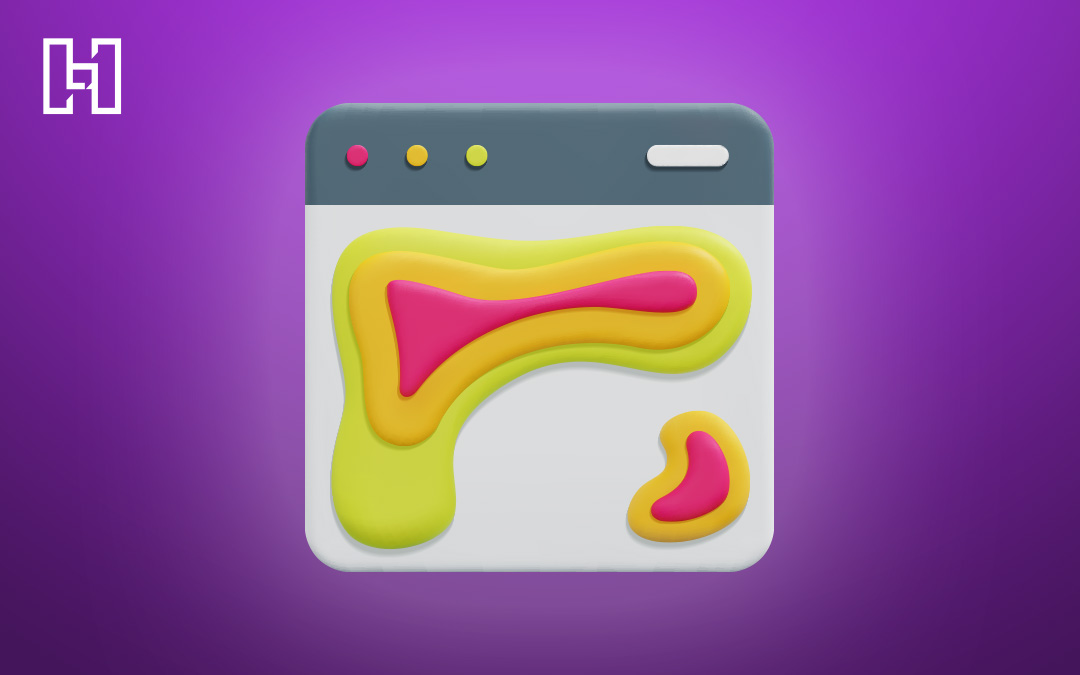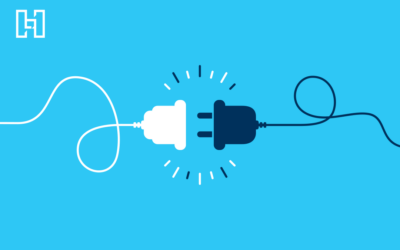Whether your goal is getting users to respond to a CTA, reducing cart abandonment on an e-commerce website, or simply seeing if site visitors like your website content, including heat mapping as part of your website optimization strategy is a simple yet powerful way to analyze user behavior and make data-driven decisions with your web design. Here’s everything you need to know about using a heat map on your website.
- What Is a Heat Map?
- What Are the Different Types of Heat Maps?
- Why Should You Use a Website Heat Map?
- What Are the Best Heat Map Tools?

What Is a Heat Map?
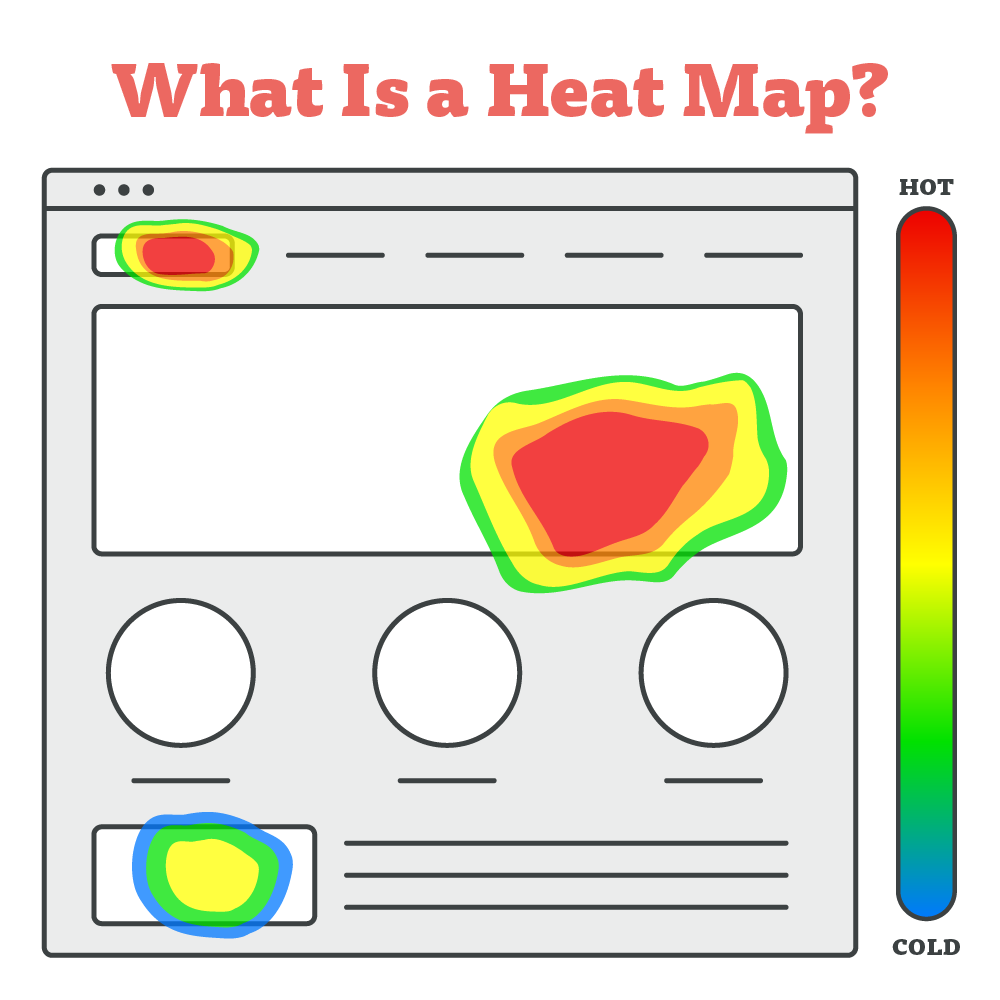
A website heat map is a data visualization tool that translates user behavior into a graphical representation similar to thermal imaging—the “hottest” areas of your website being those with the highest engagement and the “coolest” receiving the lowest. Put another way, heat maps can show you which buttons on your website users are clicking, which webpages they’re visiting most often, and what parts of those pages they spend the most time looking at, among other things.
What Are the Different Types of Heat Maps?
There are several kinds of website heat maps, but the most widely used are click maps, scroll maps, and mouse-tracking heat maps. Each shares the primary function of measuring user behavior on a website, but they have a few crucial differences.
Click Heat Maps
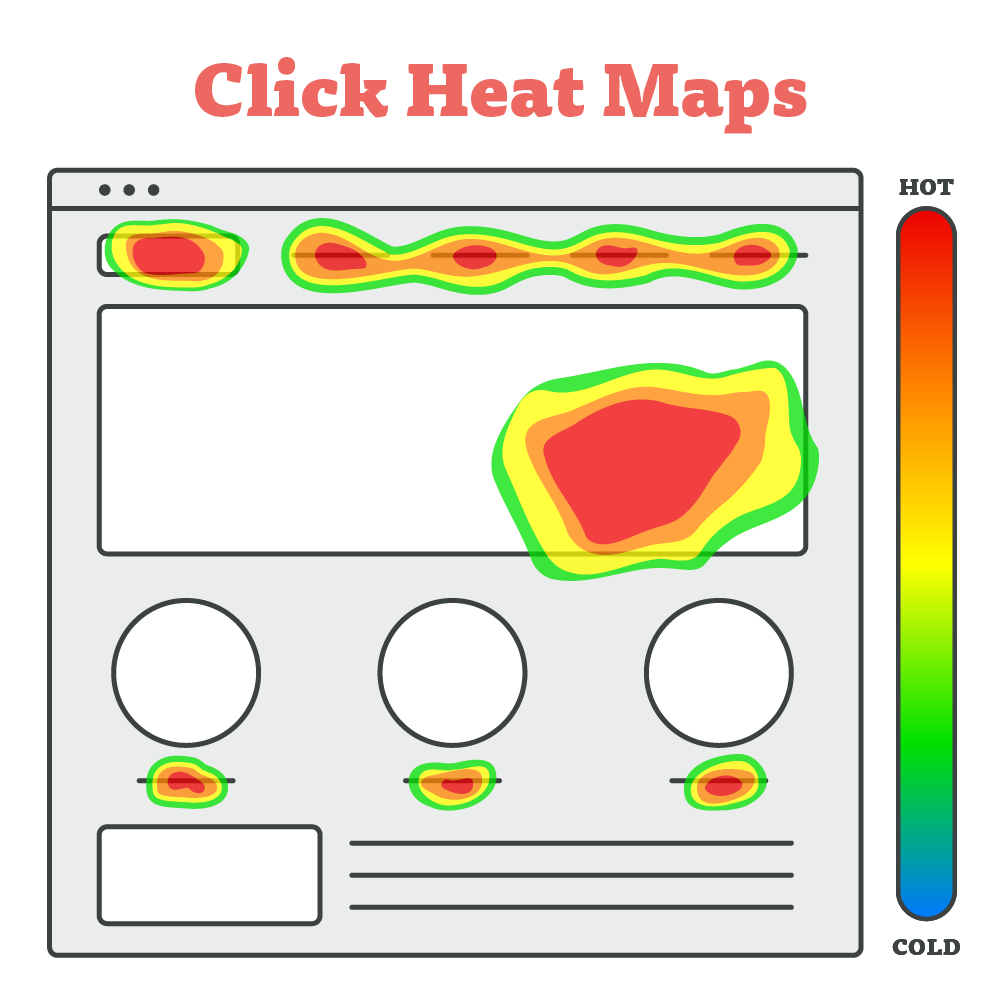
A click map is exactly what it sounds like—it’s a heat map that shows where users click most frequently on a website and its various webpages. This can give you a clear picture of how people are engaging with your website, as well as what prompts and CTAs users find most compelling.
Click heat maps can also help you identify problem areas within your website. If very few users are interacting with a certain CTA, for example, or if their clicks indicate the presence of a bug, broken link, or other site malfunction, these trends will be reflected in a website’s heat map data with user behavior like rage clicking.
Scroll Heat Maps
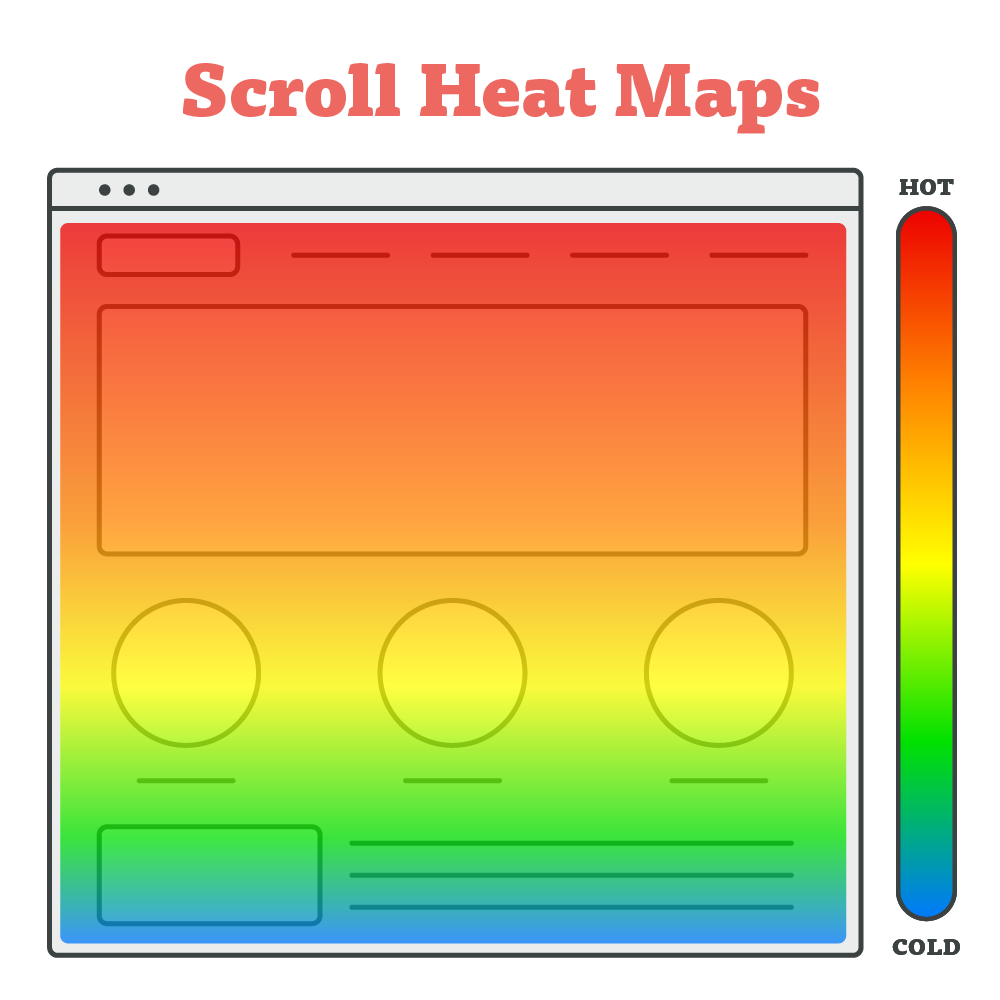
Scroll maps serve to record user behaviors that would indicate problems with the length and format of a webpage. If a user stops scrolling halfway down the page, for instance, you can safely assume that this is the point at which they lost interest or encountered trouble with something on the page. This could be because the page itself is too long or too difficult to navigate.
Scroll heat maps can also help you determine if users stop scrolling because they think the page is done, even though there’s still more content—this is known as a “false bottom.”
Mouse-Tracking Heat Maps
![]()
A mouse-tracking heat map, otherwise known as a hover map, is a combination of a click heat map and a scroll heat map. While the previous two kinds of heat maps hone in on a particular facet of user activity on a website, mouse-tracking maps measure the bigger picture of how people behave on a website.
Mouse-tracking heat maps track scrolling, clicking, and even the movement of the mouse itself. This can be valuable in showing web designers and business owners which aspects of a webpage users find most interesting outside of buttons and links alone. Users drawn to a particular image or graphic, for instance, might leave their mouse lingering over it.
Why Should You Use a Website Heat Map?
Not only does heat mapping provide your business with great customer insights, but it can also help you address serious issues with your web design that may be hindering your business’ performance online.
Collect Customer Data
If your business website has an e-commerce component, having customer data that shows which of your products are clicked on or looked at most can help you make important decisions regarding inventory, sales pushes, and even overall marketing. For example, if you know that certain products tend to drive more sales during specific seasons, you might use that information to create a timely email marketing or paid search campaign.
If a button or link on your website is rarely clicked, try making it more engaging, moving it to another area where attention is concentrated, or replicating one of your more effective calls to action to help capture your viewers’ attention.
Improve User Experience
Website analytics like time on page, exit rate, and session duration may be useful in telling you how long someone was on your website, but heat maps can better explain why they stayed or left. If your heat maps show a quick decrease in activity from the information at the top of the page to the bottom, you might have a user experience issue. Perhaps the information you’ve shared isn’t what the user was looking for or you didn’t give enough direction to keep them moving down the page. You can use heat map data to make user-friendly adjustments to your webpages and watch for improved movement down the page afterward.
Identify Website Navigation Issues
Navigation can make or break your website. With good site navigation, a heat map should show that users are clicking the right menu items that begin their journey into the sales funnel. You can see when they’re moving from top-level information pages to areas where they can request more information or make a purchase.
But with bad navigation, heat mapping may demonstrate that there is a significant drop-off from the homepage and other top-level pages. This could be an indication that you need to change your navigation to provide better guidance for site visitors so they know where they can go to take further action on your website.
What Are the Best Heat Map Tools?
Heat maps are an inexpensive tool, with many being free, offering a free trial, or having low-cost monthly subscriptions. There are a variety of heat map tools for websites available online, but below are some of the best options.
Crazy Egg
- Price: Subscriptions starting at $29/month
- Popular features: Audience targeting, Conversion tracking, Session recording
The click and scroll heat maps from Crazy Egg are divided by traffic sources, so you can see how visitors coming from platforms across the web interact differently with your site. Crazy Egg offers simple plans that don’t limit your usage to a single website, so you can use just one account for any and all of your websites. This platform offers a 30-day free trial, then five price plans that start at 30,000 tracked page views per month.
Pros
- Easy-to-understand reports
- Good value for the money
- Simple installation
- User-friendly
Cons
- Only provides heat map data—you must interpret what it means yourself
- No free version
- May be overly simple for those with advanced needs
- Customer support is lacking in some areas
Hotjar
- Price: Free or subscriptions starting at $39/month
- Popular features: Data segmentation, Session recording, Side-by-side analysis
By packaging multiple website analytics and conversion tools into one service, Hotjar stands out as one of the most effective heat mapping tools available. This tool offers click, scroll, and mouse-tracking heat maps. On top of offering session recordings, funnels, and polls, Hotjar also has an easy-to-use dashboard, making it perfect for anyone new to heat mapping. Users have up to 35 daily sessions for free and three upgraded pricing plans to choose from depending on your needs. Hotjar integrates with many common programs like Google Analytics, HubSpot, Slack, Zapier, and more.
Pros
- Continuous improvements
- Provides analytics reports
- Simple installation
- User-friendly
Cons
- Some issues with taking screenshots
- No option to create custom reports
- Not compatible with mobile apps
- Gets expensive as your business grows
Inspectlet
- Price: Free or subscriptions starting at $39/month
- Popular features: Conversion tracking, Form analytics, Session recording
Get click, scroll, and mouse-tracking heat maps with Inspectlet. This service is free up to 2,500 recorded sessions per month, and after that there are five different pricing plans. Inspectlet allows you to create surveys and see which pages users enter and exit from, which can be valuable information about what links and pages are generating traffic. This platform offers a few filtering options, so you can find the exact heat map data and sessions you need with less confusion and hassle.
Pros
- Logs browser errors
- Simple installation
- Tracks rage clicking
- User-friendly
Cons
- Customer service is lacking
- Does not offer consulting
- Not many customization options available
- Occasional glitches with session recordings
Lucky Orange
- Price: Free or subscriptions starting at $39/month
- Popular features: Audience targeting, Reporting and analytics, Session recording
The Lucky Orange heat map tool offers click, scroll, and mouse-tracking heat maps for free until you hit 500 page views per month, and then offers five different pricing plans. Lucky Orange gives users access to features like form analytics and traffic segmentation. The service also makes it possible to add polls and chat widgets to your site to promote further customer engagement. Lucky Orange integrates with several common programs such as Google Analytics, HubSpot, Shopify, and WordPress.
Pros
- Good value for the money
- Great customer service
- Helpful user interface
- Simple installation
Cons
- Limited data storage
- Does not offer consulting
- Some features can be difficult to work with
- Particular session recordings can be hard to find
Mouseflow
- Price: Free or subscriptions starting at $31/month
- Popular features: Campaign analytics, Conversion tracking, Session recording
Optimized for WordPress users, Mouseflow‘s click, scroll, and mouse-tracking heat mapping services make it simple to see how visitors are interacting with your site. Mouseflow also offers three other forms of heat mapping—attention heat maps, live heat maps, and geo heat maps. Mouseflow has a free version limited to one website with up to 500 recorded sessions and five other paid plans that let you have up to 150,000 recorded sessions on ten sites. This platform integrates with plenty of common programs like Adobe Analytics, HubSpot, Google Analytics, Zendesk, Wix, and more.
Pros
- Easy-to-understand reports
- Great customer service
- Large range of tools
- Simple to set up
Cons
- Limited filtering options
- Does not offer consulting
- Mobile version sometimes encounters issues
- Steeper learning curve for navigation
Smartlook
- Price: Free or subscriptions starting at $55/month
- Popular features: Data segmentation, Funnel analysis, Session recording
Smartlook provides comprehensive analytics and visual user insights with click, scroll, and mouse-tracking heat maps. This platform is free up to 3,000 monthly sessions, with two additional pricing plans depending on your needs. Smartlook easily integrates with common programs like HubSpot, Salesforce, Slack, and more. This tool also provides crash reports detailing where a crash occurred and what user interaction caused it, allowing you to make necessary site improvements.
Pros
- Does not slow down the website for users
- Easy-to-view recordings
- Large range of tools
- Logs browser errors
Cons
- Can be difficult to understand how to use some features
- Can’t follow a user across multiple sessions
- Data isn’t stored for very long
- Gets expensive as your business grows
VWO
- Price: Free or subscriptions starting at $200/month
- Popular features: Data segmentation, Funnel analysis, Session recording
An initialism for “visual website optimizer,” the VWO platform provides click and scroll heat maps, while also allowing you to run A/B tests on your websites, apps, and products. This platform enables you to schedule your tests at a specific time, ensuring you’re seeing data from the times most users are visiting your website. VWO is free up to 50,000 tracked users, then there are three price plans if you exceed this limit.
Pros
- Editor allows you to make quick changes when testing
- Provides detailed data
- Tests are extremely customizable
- User-friendly
Cons
- Gets expensive as your business grows
- Prices change fairly often
- Tough to test multiple variables at once
- Using the platform can cause the website to flicker for users
Want to see how your website is performing with the help of heat mapping services? Hurrdat Marketing can help test your site’s performance and improve its user experience, navigation, or overall design. Learn more about our web design services and SEO services today!
